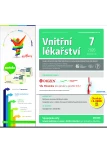Screening and brief intervention in illicit drug users
Authors:
Jana Malinovská 1,2; Barbora Švarcová 3; Ludmila Brunerová 4; Sabina Pálová 1; Jan Brož 1
Authors‘ workplace:
Interní klinika 2. LF UK a FN Motol, Praha
1; Adiktologická poradna, specializované pracoviště Area fausta, Praha
2; Psychiatrické oddělení, Ústřední vojenská nemocnice – Vojenská fakultní nemocnice, Praha
3; II. interní klinika 3. LF UK a FNKV Praha
4
Published in:
Vnitř Lék 2020; 66(7): 450-454
Category:
Overview
Illicit drug use is quite prevalent in the Czech population with a lifetime prevalence of illicit drug use being 29.7 % in 2018. People who use illicit drugs can use health care services more often and they are thus relevant in early identification of illicit substance use disorders and in providing brief intervention. Primary evaluation of presence of illicit substance use disorders can be done using simple and fast screening questionnaires, such as DAST-10. Screening is followed with time effective brief intervention that includes education, advice and motivation for ceasing drug use. Brief intervention should always precede potential referral to specialised addiction services. Implementation of the evidence-based guidelines into daily practise can have a positive effect on early problem resolution, lead to reduction or termination of substance use and decrease harms on patient’s health and other areas of his life. Screening of illicit drug use, brief intervention in case of positive screening and eventual referral to a specialist should be implemented into routine medical care.
Keywords:
addictive substances – brief intervention – early diagnostics – illicit drugs – screening
Sources
1. Pilowsky DJ, Wu LT. Screening for alcohol and drug use disorders among adults in primary care: a review. Subst Abuse Rehabil 2012; 3(1): 25–34. https://doi.org/10.2147/SAR.S30057
2. D’Amico EJ, Paddock S, Burnam A, Kung, F. Identification of and guidance for problem drinking by general medical providers: results from a national survey. Med Care 2005; 43(3): 229–236.
3. Mravčík V, Chomynová P, Grohmannová K et al. Výroční zpráva o stavu ve věcech drog v České republice v roce 2018. Mravčík V. (Ed.). Praha: Úřad vlády České republiky 2019.
4. Cherpitel CJ, Ye Y. Drug use and problem drinking associated with primary care and emergency room utilization in the US general population: data from the 2005 national alcohol survey. Drug Alcohol Depend 2008; 97(3): 226–230. https://doi.org/10.1016/j.drugalcdep.2008. 03. 033
5. Madras BK, Compton WM, Avula D et al. Screening, brief interventions, referral to treatment (SBIRT) for illicit drug and alcohol use at multiple healthcare sites: comparison at intake and 6 months later. Drug Alcohol Depend 2009; 99 (1–3): 280–295. https://doi.org/10.1016/j.drugalcdep.2008. 08. 003
6. Kabíček P, Sulek Š, Mizerová L et al. Projekt screeningu a krátké intervence v ordinaci praktického lékaře pro děti a dorost vedoucí k snížení zneužívání návykových látek v adolescenci. Čes -slov Pediat 2010; 65(11): 654–659.
7. Csémy L, Kabíček P, Dvořáková Z. Krátké intervence pediatra zaměřené na redukci užívání návykových látek u adolescentů. Vox pediatriae 2013; 13(6): 28–30.
8. Kabíček P, Vacek J, Csémy L. Skrínink a krátká intervence v oblasti návykových látek v praxi praktického lékaře pro děti a dorost. Adiktol prevent léčeb praxi 2019; 2(2): 94–97.
9. Kurti AN, Keith DR, Noble A et al. Characterizing the intersection of co -occurring risk factors for illicit drug abuse and dependence in a U.S. nationally representative sample. Prev Med 2016; 92:118–125. doi:10.1016/j.ypmed.2016. 09. 030
10. Smith PC, Schmidt SM, Allensworth -Davies D, Saitz R. A single -question screening test for drug use in primary care. Arch Intern Med 2010; 170(13): 1155–1160. https://doi. org/10.1001/archinternmed.2010.140
11. Yudko E, Lozhkina O, Fouts A. A comprehensive review of the psychometric properties of the Drug Abuse Screening Test. J Subst Abuse Treat 2007; 32: 189–198.
12. Skinner H. The Drug Abuse Screening Test. Addict Behav 1982; 7: 363–371.
Labels
Diabetology Endocrinology Internal medicineArticle was published in
Internal Medicine

2020 Issue 7
Most read in this issue
- Hypoglycemia in non -diabetic patients
- Metformin -associated lactic acidosis
- Coagulopathy associated with COVID-19
- CAR T-cells: hot news in cancer therapy
